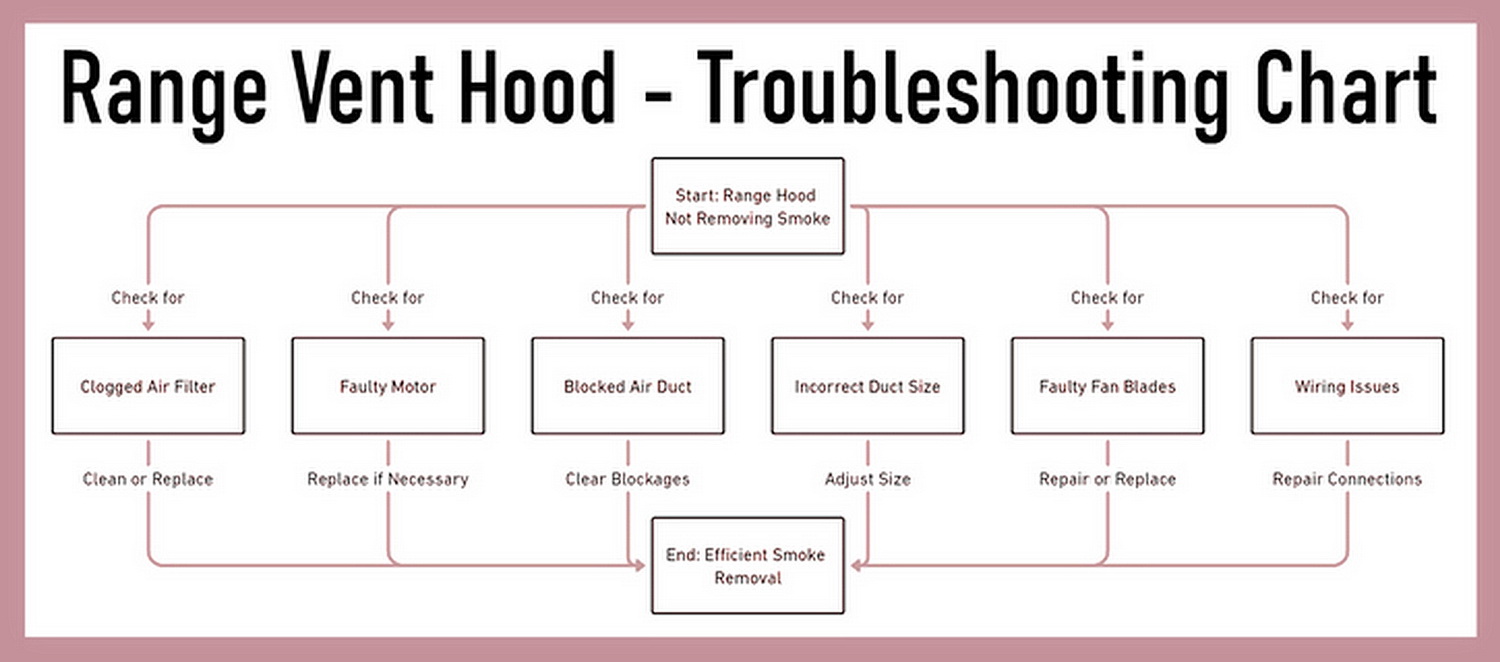Your range hood is used to remove smoke and odors from the kitchen. If it doesn’t work correctly, it can lead to heavy smoke not being suctioned out and grease buildups. Let us show you 6 methods to help you fix your range hood’s performance.
 Kitchen range vent hood does not remove smoke, how do I fix it?
Kitchen range vent hood does not remove smoke, how do I fix it?
Most common reason for smoke not being removed by range hood? Dirty filters are a primary reason for kitchen vent hoods failing to remove smoke. These filters, designed to trap grease, smoke, and debris during cooking, can become clogged over time. This buildup restricts airflow and causes the issue we are talking about. Regular cleaning or replacement of these filters is needed.
Range Hood (Not Removing Smoke) Solutions
| Problems (Parts or Components) | Solutions |
|---|---|
| Clogged Air Filter | Clean with soapy water or replace if too dirty or damaged. |
| Faulty Motor | Inspect for damage and replace with a suitable new motor. |
| Blocked Air Duct | Check for obstructions and clear any blockages found. |
| Faulty Fan Blades | Examine for wear or misalignment and repair or replace as needed. |
| Wiring Issues | Inspect for loose or damaged wiring and repair or replace. |
| Incorrect Duct Size | Ensure duct size matches the recommended specifications. |
1. Clogged Air Filter
The air filter is a crucial component of your range hood, responsible for trapping grease and other particles. Over time, these particles accumulate, leading to clogs that impede airflow. To address this, first remove the filter and inspect it for grease and debris. If the filter is reusable, wash it thoroughly with warm, soapy water or place it in a dishwasher if it’s dishwasher-safe. After washing, ensure the filter is completely dry before reinstalling it. For filters that are non-reusable or too clogged to clean effectively, replace them with new ones that match your range hood’s specifications.
How To Clean Vent Hood Filter
2. Faulty Motor
The motor is the heart of your range hood, driving the fan that circulates air and removes smoke. If the motor is not functioning correctly, the hood’s effectiveness decreases significantly. Begin by inspecting the motor for any signs of damage, such as burnt areas or unusual noises during operation. If the motor is indeed faulty, it’s usually more practical to replace it rather than repair it. Make sure to choose a replacement motor that aligns with your range hood’s model and specifications for optimal performance.
Range Hood Fan Replacement
3. Blocked Air Duct
Air ducts play a vital role in ventilating smoke out of your kitchen. A blockage in these ducts can severely hinder this process. Start by inspecting the entire length of the ductwork for any obstructions, such as bird nests, accumulated grease, or debris. Removing blockages might require disassembling parts of the ductwork or using specialized cleaning tools. After clearing the duct, reassemble it securely to ensure proper ventilation.
4. Faulty Fan Blades
Fan blades that are damaged or misaligned can significantly impact the performance of your range hood. Inspect the blades for any signs of wear, damage, or misalignment. If the blades are damaged, they should be replaced. It’s crucial to ensure that the replacement blades are properly aligned and securely attached to provide effective smoke removal.
5. Wiring Issues
Proper electrical connections are essential for the range hood to function correctly. Begin by inspecting all electrical connections within the hood for any signs of loose or damaged wires. Secure any loose connections and replace damaged wires as needed. If you’re not confident in handling electrical components, it’s advisable to consult a professional to avoid any safety risks.
6. Incorrect Duct Size
The efficiency of a range hood can also be affected by the size of the ducts used. If the duct is too narrow, it restricts airflow; if it’s too wide, it decreases the suction power of the hood. To correct this, first consult your range hood’s manual to determine the recommended duct size. If the current duct size doesn’t match these recommendations, consider adjusting the ductwork. This might involve installing new ducts that are more appropriately sized for your range hood.
Pro Tip: Regular maintenance, including cleaning the filters and inspecting the ductwork and motor, can prevent many common issues with range hoods. Addressing small problems early can save time and money in the long run.
 Range Vent Hood troubleshooting chart for guidance
Range Vent Hood troubleshooting chart for guidance
FAQ Section
How often should I clean my range hood filters?
It’s recommended to clean your filters every 1 to 3 months, depending on your cooking frequency.
Can I repair a range hood motor myself?
If you have appliance repair experience, you may be able to replace the motor. Otherwise, it’s safer to consult a professional.
What is the ideal duct size for a range hood?
The ideal size varies by model. Refer to your range hood’s manual for the manufacturer’s recommendations.
Ask an Appliance Technician
Issues with your range hood or need more detailed advice? Feel free to ask questions or comment below for further assistance. Including your range hood model number will help in providing more specific advice.



Leave a Reply